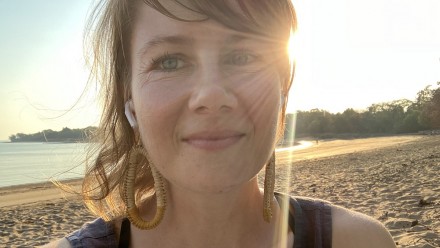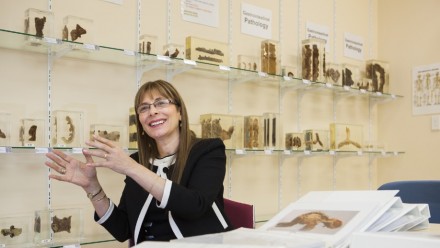A study of the human heart
When Professor Jane Dahlstrom shows you around the Peter Herdson Pathology Museum at the Canberra Hospital, her tour is a little more personal than you might expect.
Walking slowly along the shelves of specimens, she indicates a spleen, preserved in fluid and encased in perspex, and says, “Yes, I remember that patient.” A bit further along, she points to the cross-section of a tumour. “That’s from another I have met.”
While it might appear to the outsider as a collection of medical curiosities, or a display catalogue of what can go wrong with the human body, Professor Dahlstrom sees the personal story and generosity behind each specimen, donated to assist ANU medical students in studying pathology.
“Ninety-five percent of people we ask to donate say yes,” she says. “The generosity in allowing these to be used in teaching is extraordinary.”
Professor Dahlstrom, the new Interim Dean of the ANU College of Health and Medicine, is an anatomical pathologist working at the Canberra Hospital.
It’s a job she sees as being “the centre of the universe.”
“In pathology we make the diagnosis that determines the prognosis and treatment for that patient. People think of us as not being involved in patient care, but we’re core to it. What I say makes a big difference to how the patient might decide to live the rest of their life.
“I’m definitely aware of that while I’m looking down the microscope. The last few weeks I’ve had a lot of tongue cancers in relatively young people. I feel the weight of it sometimes because I know the consequences of my diagnosis are severe.”
Professor Dahlstrom’s work also incorporates perinatal pathology, in which she contributes to important research on improving global understanding and awareness on stillbirth.
Conducting autopsies on stillborn babies is, she says, as difficult as it sounds, but can provide comfort and information to families desperately looking for answers.
“Doctors are human, but empathy helps you, I think. I have helped to raise six kids so I can honestly say I know the highs and lows of being a parent.
“And there can be happy endings in perinatal pathology too. There was one particular family where they had suffered three losses, and I was at least able to give them an answer as to why.
“A year or two later, I saw a paper on a particular treatment for the mother’s condition, so I contacted her immunologist and obstetrician and said she might benefit from it. “Then one day, I received a note at the hospital: ‘Beautiful baby, come and see me!’ The mother had ended up with a perfectly healthy baby. It really was wonderful. How often does a pathologist get a request to visit a patient they’ve never even met before?”
Professor Dahlstrom says she brings her human touch to what could be the faceless side of medicine in part because of her own experience being on the other side of the diagnosis.
“At the time I was diagnosed with breast cancer, in 2003, I was actually the chair of the Breast Cancer Treatment Group for the ACT and South East NSW.
“Having my own cancer journey as a doctor, while it was incredibly inconvenient, was really helpful in my own personal development. It made me think about the patient perspective more than I used to.
“It’s made me much more content. I just want to enjoy every day and get the most out of it. If you have that calm inside you, it’s pervasive.”
And it is. Even in an impersonal printout of pathology test results, there’s a human heart behind it.
Professor Dahlstrom teaches pathology in the MChD (Doctor of Medicine and Surgery) program. Find out more about studying medicine at ANU














